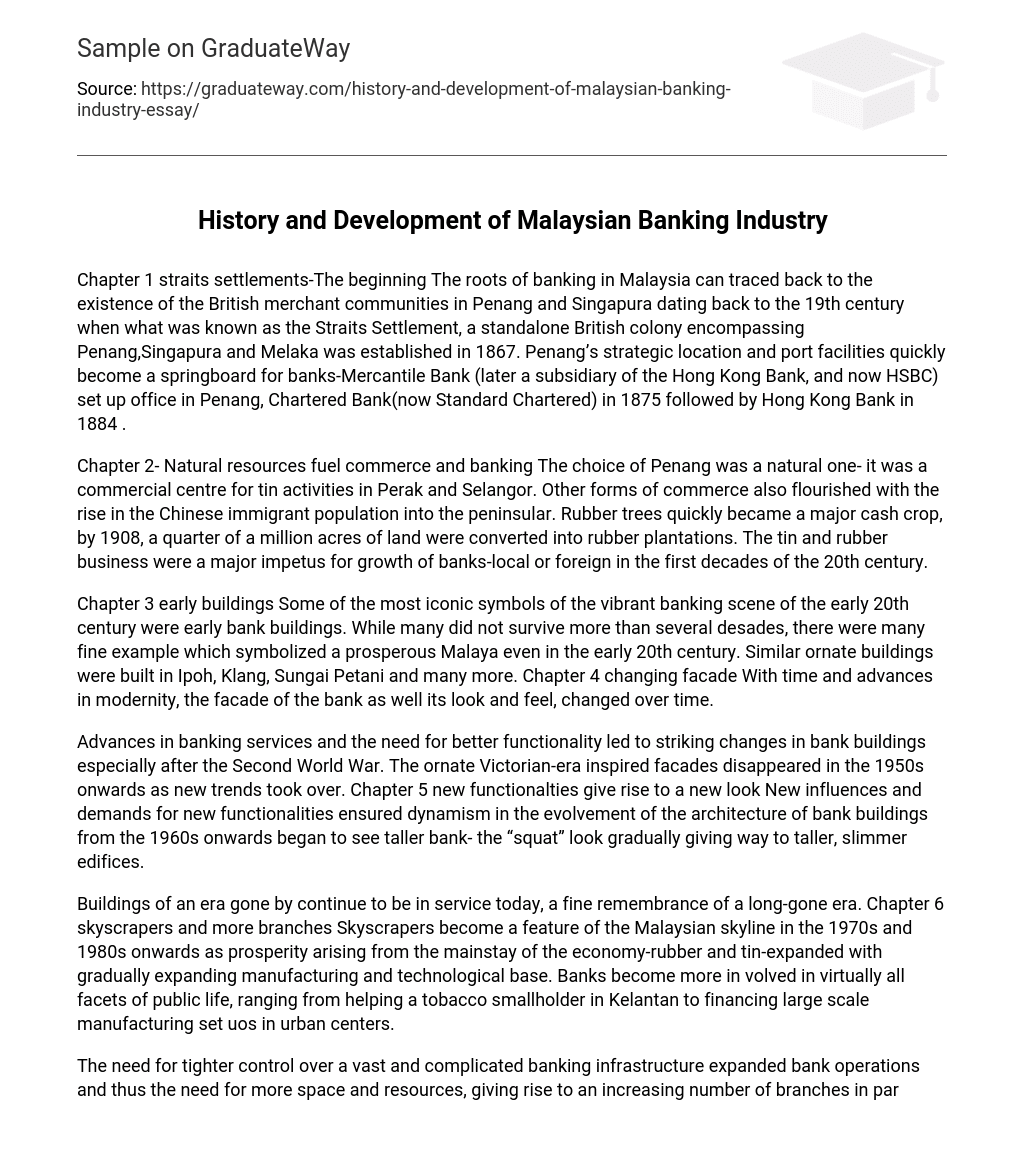Chapter 1 straits settlements-The beginning The roots of banking in Malaysia can traced back to the existence of the British merchant communities in Penang and Singapura dating back to the 19th century when what was known as the Straits Settlement, a standalone British colony encompassing Penang,Singapura and Melaka was established in 1867. Penang’s strategic location and port facilities quickly become a springboard for banks-Mercantile Bank (later a subsidiary of the Hong Kong Bank, and now HSBC) set up office in Penang, Chartered Bank(now Standard Chartered) in 1875 followed by Hong Kong Bank in 1884 .
Chapter 2- Natural resources fuel commerce and banking The choice of Penang was a natural one- it was a commercial centre for tin activities in Perak and Selangor. Other forms of commerce also flourished with the rise in the Chinese immigrant population into the peninsular. Rubber trees quickly became a major cash crop, by 1908, a quarter of a million acres of land were converted into rubber plantations. The tin and rubber business were a major impetus for growth of banks-local or foreign in the first decades of the 20th century.
Chapter 3 early buildings Some of the most iconic symbols of the vibrant banking scene of the early 20th century were early bank buildings. While many did not survive more than several desades, there were many fine example which symbolized a prosperous Malaya even in the early 20th century. Similar ornate buildings were built in Ipoh, Klang, Sungai Petani and many more. Chapter 4 changing facade With time and advances in modernity, the facade of the bank as well its look and feel, changed over time.
Advances in banking services and the need for better functionality led to striking changes in bank buildings especially after the Second World War. The ornate Victorian-era inspired facades disappeared in the 1950s onwards as new trends took over. Chapter 5 new functionalties give rise to a new look New influences and demands for new functionalities ensured dynamism in the evolvement of the architecture of bank buildings from the 1960s onwards began to see taller bank- the “squat” look gradually giving way to taller, slimmer edifices.
Buildings of an era gone by continue to be in service today, a fine remembrance of a long-gone era. Chapter 6 skyscrapers and more branches Skyscrapers become a feature of the Malaysian skyline in the 1970s and 1980s onwards as prosperity arising from the mainstay of the economy-rubber and tin-expanded with gradually expanding manufacturing and technological base. Banks become more in volved in virtually all facets of public life, ranging from helping a tobacco smallholder in Kelantan to financing large scale manufacturing set uos in urban centers.
The need for tighter control over a vast and complicated banking infrastructure expanded bank operations and thus the need for more space and resources, giving rise to an increasing number of branches in parts of Malaysia. Chapter 7 banking halls- a look back in time Banking halls where bank officers and customers interact have also changed tremendously over the last 100 years. In the early days, a bank in many instances was just an office with a “strongroom” i. e. a safe.
This was still practiced as late as the early 1950s in Sabah and Sarawak. The prosperity enjoyed by Peninsular Malaysia in the late 1930s and post-World War Two saw banking halls expand. Deposit taking became more prevalent amongst the populace; trust in banks multiplied especially after the dark days of bank runs and failures in the early 1930s. to cope with more customers, banking halls evolved as well. Customers comprised not just businessmen and merchants but also housewives. Chapter 8 space and color
Banks continue to emphasize customer service and interaction just like was decades ago. However with automation, customer relationship moved to a higher plane. There was order and no crowds in the old days. Chapter 9 the era of computers Today, we take 24-hour banking for granted but the seeds of computerization of banking services began in Malaysia as early as 1960s. Rapid advancements in technology and automation from then onwards quickly expanded banking services beyond our shores. Chapter 10 technological advances
Rapid technological advances in all facets of banking from services to money market are impressive from the 1980s to present day. Chapter 11 the first ATM The first automated machine(ATM) in Malaysia was launched by Maybank in 1981 at its Ampang Park branch. ATMs certainly the day-to-day relationship between a bank and its customers profoundly. Chapter 12 bringing banking to customers Even before the era of ATMs, mobile banking was already introduced in many parts of rural Malaysia in the 1970s.
In an era long gone, actual banking buses were introduced by some banks to bring services and conveniences to the rural population. Chapter 13 paradigm shift In the 21st century, a paradigm shift in banking practices has been taken root: internet and mobile banking. Malaysia with a fast growing upwardly mobile, educated population is in the forefront of creating demand for internet and mobile banking. The last 100 years has seen tremendous changes in banking. This is a indeed a strong reflection of dynamism and evolution in local banking practices.





